#high voltage software
Explore tagged Tumblr posts
Photo

15 notes
·
View notes
Text
I completely understand it was for story reasons, but kid me was SO pissed that you weren't able to play as all ten aliens in Ben 10: Protector of Earth.
Like, they could've had you take down that giant robot at the beginning by using Grey Matter and messing it up from the inside, included a few more boss battles across the map so you could gradually unlock the other aliens, had an underwater boss that you needed to defeat with Ripjaws. So much potential.
Maybe once you complete the game and get the rest of the Omnitrix crystals back, it would've unlocked some of Ben's additional aliens like Wildvine, Upchuck, Ditto, Eye Guy, etc so you can replay the levels with them.
I'm just saying, do you have ANY idea how badly I wanted to kick ass as Diamondhead, High Voltage Software?!
#ben 10 protector of earth#ben 10#video games#high voltage software#d3 publisher#cartoon network#classic cartoon network#gaming#ps2 games#wii games#psp games
7 notes
·
View notes
Text
Let's Play Hunter: The Reckoning |12| Carpenter's Rage
After a mad dash through the sewers after recovering from a slight mental breakdown, it's time to look for Arkady in Death Row. But before we do, we get to say hello to Carpenter one last time. Before we chop him up you see.
#hunterthereckoning #retro #horror
youtube
#Hunter: The Reckoning#2002#Hack And Slash#RPG#Tapletop RPG#TTRPG#modern#World of Darkness#High Voltage Software#Gamecube#Xbox#Interplay Entertainment#co-op#multiplayer#undead#hunter#vampire#zombie#ghouls#werewolf#horror#Youtube
2 notes
·
View notes
Text
The Conduit - Episode 8: The Finale
Today on The Conduit, we finish off this Let’s Play!
#High Voltage Software#Kallias#Let&039;s Play#Let&039;s Play The Conduit#Let&039;s Play The Conduit WiiDa12thKind#LGBT Creator#LGBTQIA+#LGBTQIA+ Creator#Nintendo#Nintendo Wii#Non-Binary Creator#nonbinary#queer#Queer Creator#Queer Let’s Player#The Conduit#Trans Creator#Trans Femme#trans gamer girl#Trans Let’s Player#Trans Woman#Walkthrough Guide Playthrough#Wii
0 notes
Text
Academic Blog #8
Transmedia and Ben 10
In this blog, I will be discussing transmedia with the example of one of the most famous show, Ben 10 (2005).
Plot:
Ben 10 is a show that was released on Cartoon Network back in 2005. The show revolves around a kid named Ben Tennyson. He goes to a summer trip with his grandpa Max Tennyson and cousin Gwen Tennyson. On his journey, Ben finds an alien gadget watch, called Omnitrix, that allows him to transform into 10 different aliens. Other alien beings then come to earth to steal the gadget from Ben or take over the world and Ben, along with his grandpa and cousin, stops them throughout the series.

Analysis:
Ben 10 has been around quite a long time. Back when it was coming soon, in 2005, I was in school and would always watch the trailers. However, the show took everything and everyone by storm. It became among the most popular brand in the world.
Now, how does it fit in the context of transmedia. Well, we know that transmedia is “A process where integral elements of a fiction get dispersed systematically across multiple delivery channels for the purpose of creating a unified and coordinated entertainment experience.” (Jenkins 2011).
Ben 10 started off as a kids show but it became so popular in a few years that it was everywhere. From simple merchandises like school bags, dolls and watch toys to video games, card games and board games. They were very popular not only in the western region, where they were officially released, but even different parts of the globes like Middle East, Southeast Asia.


The Ben 10 hype continued as the show turned into live action movies and video games. Ben 10 then received a new direct sequel, Ben 10 Alien Force. This, again, increased the popularity of the already popular show. Now, there were more merchandises of Ben, Gwen, Kevin, and others. Action figures became popular. There were holographs, VR games etc. Ben 10 Alien Force introduced a new omnitrix and new aliens which made the show fresh. The show also took elements from its prequel, like characters, references, worlds and villains.
After this, till now, Ben 10 is an ongoing series. It now has sequels like Ben 10 Ultimate alien, omniverse and remakes like Ben 10 (2020). New video games and new merchandises are always coming and people enjoy it.

Conclusion:
Transmedia means telling a story or using a story in different mediums for majority of the people to enjoy it. So, if someone is not into shows, they may enjoy video games and the definition is quite vast when you think about it. That is why, transmedia is a one of the most popular ways to reach as many people as possible.
Bibliography:
Jenkins, H. (2011) “Transmedia 202: Further Reflection,” Henry Jenkins Pop Junction, 31 July. Available at: http://henryjenkins.org/blog/2011/08/defining_transmedia_further_re.html
Ben 10 (2005), Created by Man of Action [Show], Cartoon Network.
Ben 10: Alien Force (2008), Created by Man of Action [Show], Cartoon Network Studios.
Ben 10: Ultimate Alien (2010), Created by Man of Action [Show], Cartoon Network Studios.
Ben 10: Race Against Time (2007), Directed by Alex Winter [Film], Alive and Kicking, Inc. and Cartoon Network.
High Voltage Software (2007), Ben 10: Protector of Earth [Video game], High Voltage Software.
1 note
·
View note
Text
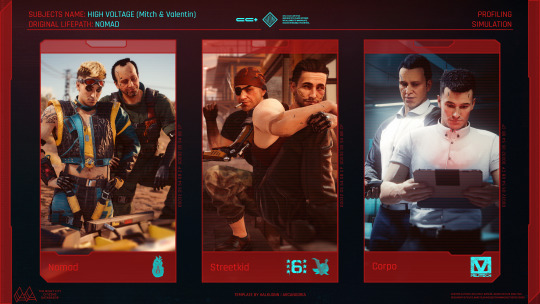
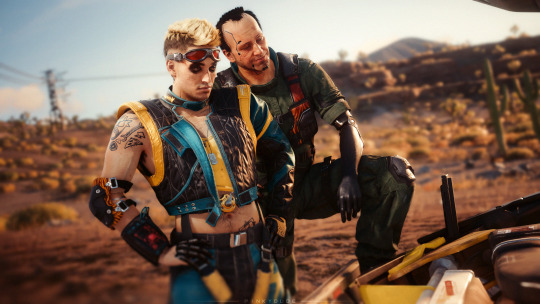
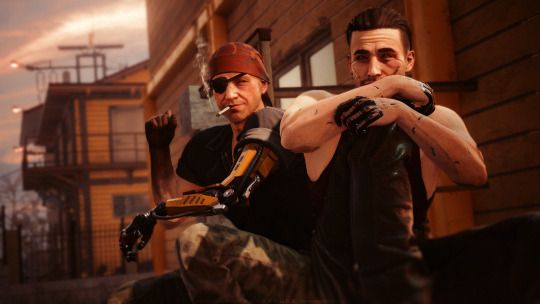

Valentin & Mitch | 645/?? | Lifepath AUs 🌵🌆💻 ▶ Lifepath template by @arcandoria 🧡
#Cyberpunk 2077#Mitch Anderson#Valentin Da Silva#Aldecaldos#OTP: High Voltage#MLM#Screenshot#Virtual Photography#Felt like reposting this 😩😩#ngl I'm still ghuezhiughuiez hooked on street kid and corpos AU#Mitch doesnt LOOK LIKE HIMSELF AS A CORPOOOO LOOKATHIM 👁👄👁#I deadass just... swapped his cyebrware for Meredith's and used Vik's hair (I think)#but yeh basically- Street Kid Valentin is a.. Valentinos HAH#and Mitch is a 6th street#Tinos!Valentin sneaking some PTSD pills to 6th!Mitch and often getting caught by others 6th members#and getting beat up cause well they don't like valentinos roaming their streets#but Mitch often runs out of pills and Val doesn't went him to turn psycho#As for their corpos asses- Mitch is a Militech engineer watchin' over trainee Da Silva#who accidently breached into some of their servers's ICE while attempting to upgrade it with some illegal software#AHUGEZHUI Their appearances and lores aren't too developped but 👁👄👁 YEH
56 notes
·
View notes
Text

UK 1998
#UK1998#MINDSCAPE#HIGH VOLTAGE SOFTWARE INC.#ACTION#SPORTS#BASKETBALL#IBM#PS1#WORLD LEAGUE BASKETBALL
9 notes
·
View notes
Text
Vehicle Recall: Mercedes-Benz AMG GT Coupes & Sedans:
#25V129000#crash hazard#Daimler AG#Electronics#High-voltage Starter Alternator Control Unit#High-voltage Starter Alternator Control Unit Software#Hybrid Powertrain#injury hazard#Laceration hazard#loss of vehicle control hazard#Mercedes AMG#Mercedes Benz USA LLC#NHTSA#NHTSA Campaign Number: 25V129000#oss of drive power#Recalls Direct RIN: 19579-2025#Software miscoding and/or malfunction#US National Highway Traffic Safety Administration ("NHTSA")
0 notes
Text
Athletes Go for the Gold with NASA Spinoffs
NASA technology tends to find its way into the sporting world more often than you’d expect. Fitness is important to the space program because astronauts must undergo the extreme g-forces of getting into space and endure the long-term effects of weightlessness on the human body. The agency’s engineering expertise also means that items like shoes and swimsuits can be improved with NASA know-how.
As the 2024 Olympics are in full swing in Paris, here are some of the many NASA-derived technologies that have helped competitive athletes train for the games and made sure they’re properly equipped to win.
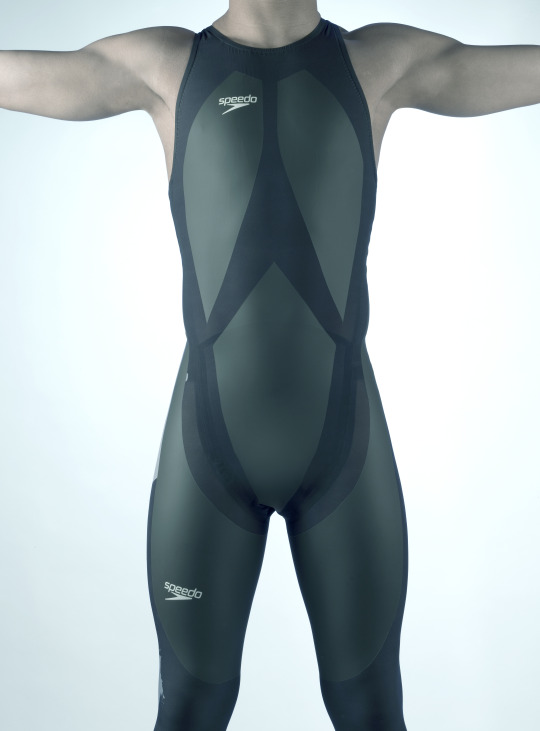
The LZR Racer reduces skin friction drag by covering more skin than traditional swimsuits. Multiple pieces of the water-resistant and extremely lightweight LZR Pulse fabric connect at ultrasonically welded seams and incorporate extremely low-profile zippers to keep viscous drag to a minimum.
Swimsuits That Don’t Drag
When the swimsuit manufacturer Speedo wanted its LZR Racer suit to have as little drag as possible, the company turned to the experts at Langley Research Center to test its materials and design. The end result was that the new suit reduced drag by 24 percent compared to the prior generation of Speedo racing suit and broke 13 world records in 2008. While the original LZR Racer is no longer used in competition due to the advantage it gave wearers, its legacy lives on in derivatives still produced to this day.

Trilion Quality Systems worked with NASA’s Glenn Research Center to adapt existing stereo photogrammetry software to work with high-speed cameras. Now the company sells the package widely, and it is used to analyze stress and strain in everything from knee implants to running shoes and more.
High-Speed Cameras for High-Speed Shoes
After space shuttle Columbia, investigators needed to see how materials reacted during recreation tests with high-speed cameras, which involved working with industry to create a system that could analyze footage filmed at 30,000 frames per second. Engineers at Adidas used this system to analyze the behavior of Olympic marathoners' feet as they hit the ground and adjusted the design of the company’s high-performance footwear based on these observations.

Martial artist Barry French holds an Impax Body Shield while former European middle-weight kickboxing champion Daryl Tyler delivers an explosive jump side kick; the force of the impact is registered precisely and shown on the display panel of the electronic box French is wearing on his belt.
One-Thousandth-of-an-Inch Punch
In the 1980s, Olympic martial artists needed a way to measure the impact of their strikes to improve training for competition. Impulse Technology reached out to Glenn Research Center to create the Impax sensor, an ultra-thin film sensor which creates a small amount of voltage when struck. The more force applied, the more voltage it generates, enabling a computerized display to show how powerful a punch or kick was.

Astronaut Sunita Williams poses while using the Interim Resistive Exercise Device on the ISS. The cylinders at the base of each side house the SpiraFlex FlexPacks that inventor Paul Francis honed under NASA contracts. They would go on to power the Bowflex Revolution and other commercial exercise equipment.
Weight Training Without the Weight
Astronauts spending long periods of time in space needed a way to maintain muscle mass without the effect of gravity, but lifting free weights doesn’t work when you’re practically weightless. An exercise machine that uses elastic resistance to provide the same benefits as weightlifting went to the space station in the year 2000. That resistance technology was commercialized into the Bowflex Revolution home exercise equipment shortly afterwards.
Want to learn more about technologies made for space and used on Earth? Check out NASA Spinoff to find products and services that wouldn’t exist without space exploration.
Make sure to follow us on Tumblr for your regular dose of space!
2K notes
·
View notes
Text


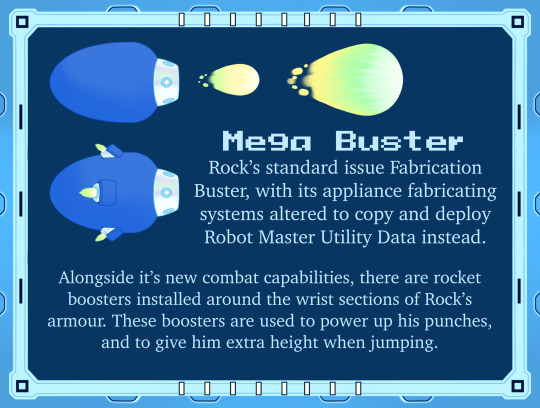
Rock’s AU design is finished, he's got a profile under the cut :)
Rock Light / Mega Man:
Construction Purpose: Rock was built for housework and lab assistance after Light was severely injured in the 28/XX incident. After the first Wily Takeover, his fabricator was altered for combat, and his house duties fell to Roll.
Biggest Strength: He knows exactly what he fights for, and why.
Biggest Flaw: He tends to lose sight of himself in battle, focusing solely on his motivations regardless of what happens to him.
Weaknesses: His armour is built to withstand a variety of situations, but his Helper Unit origin makes him particularly susceptible to high voltage attacks.
Battle Style: Rock tries to be diplomatic and tactical about fighting, trying to talk his opponent down until the last possible moment. If talking isn’t an option, he likes to get things done as quickly and painlessly as he can. After all the battles he's fought, he's gotten quite good at spotting the weaknesses of Wily's robots.
Misc Notes:
Due to a malfunction in his colour changing software, the bottom of Rock’s hair has permanently turned blue-black.
He’s a very avid scrap-booker.
He stopped attending school in person after becoming Mega Man. Too much attention.
After Light became more self sufficient again, Rock started helping design the Robot Master’s cosmetics instead of helping to build them.
He gets along well with all the Light Numbers, but he’s closest with Cut Man.
The rollerblades aren’t retractable. He’s just that good on skates.
Despite insisting he doesn’t see any of the Wily bots as rivals, he actually does. It’s Top Man.
Even though he doesn’t really enjoy being Mega Man, he does like that people see him as a hero.
----
Rush Notes:
Roll built him, technically as a birthday present for Rock.
He’s a based on a border collie.
He was built from the broken pieces of item 1, 2 and 3, whilst Rock was recovering from his battles with Wily’s first numbers.
His serial number stands for Light Companion Number.
#The next one to get a profile like this will probably be Roll#I might try to format the profile bit a little differently? idk#mega man#megaman#rock light#my art#Megaman Soul Core#Mega Man Soul Core au#the au name might change but I like Soul Core for now :)#man I have so much lore for this already it is overwhelming#I will be making a lore post to explain some stuff at some point
118 notes
·
View notes
Text
On Bodging Silly Mistakes
After a few weeks of rest and working on non-homebrew-related projects since getting my 68030 stack running 8-user BASIC, I've circled back around to the project. My goal is to have it ready to exhibit for VCF Southwest 2025 in June.
The first thing to do when picking up an old project is to make sure it still works to begin with.
It did not.
The computer would start up, go through its boot process, and start the user programs. The supervisor terminal would accept and execute commands, but none of the user terminals would accept input.
I could tell the serial data was making it to the machine, because my 8-port serial card has indicator LEDs on the Transmit & Receive signals and they were working as expected. If I held down a key as the system booted, it would print that character a few times before stopping and then no longer accept any more data. So it really looked like the hardware was working. Nothing had changed in software so that wasn't likely to be the issue.
It reminded me of the problems I encountered with reading from disk when CPU cache was preventing the updated disk status bit from being read. The serial card supports asserting the CPU's Cache Inhibit signal, but perhaps that circuit wasn't functioning. There was no change with it connected or not. Time to break out the oscilloscope. The Cache Inhibit signal was always low — always asserted. Cache wasn't the problem because cache was effectively always disabled.
Out of ideas, it was time to break out the logic analyzer. The I/O Read & Write signals on the serial card were working as expected, and it was properly addressing the card & its individual ports. So next thing was to check was the actual data being read from the UARTs.
Letting the logic analyzer run and watching the data fly through, the problem finally made itself known — the UARTs were not setting bit 0 of the status byte to indicate that they had received data. The data was getting to the UART, it just wasn't acknowledged.
But why? And why did it work initially on restart and then stop? And why did it work without issue a few weeks ago? What is different?
What is different, indeed. I have made one change to the hardware since I last ran it — I added a proper watchdog/power-on-reset controller. If the power supply drops below 4.7 volts, it will reset the computer. The power supply I had been using was marginal and was getting caught by the watchdog, so I switched to a proper power PC supply.
So what's different since last time I ran the system is my reset circuit is more effective and the system voltage should be much more stable 5V.
And that's when I realized a mistake I made in the design for my 8-port serial card. The 68k reset signal is active-low and the 16C55x UART reset signal is active-high. I was trying to minimize part count, and didn't have an inverter for the reset signal, so I used what I had on hand — a buffer with an active-low enable signal.

Anyone well-versed in electronics may already see the problem.
When the CPU-RESET# signal is asserted (low), the buffer will set its output, IO-RESET to match its input, VCC (high). That's great, we get a high signal on the output whenever the CPU Reset signal is low.
Except ... what happens when the CPU Reset signal is not asserted? The buffer goes open-collector and doesn't pull the IO-RESET signal one way or the other; it's just left floating.
Floating signals are bad news for digital circuits. Their behavior is unpredictable and subject to environmental noise, power fluctuations, etc. For my IO-RESET signal to function properly, something needs to pull it low whenever the 74'125 buffer is not actively driving it high. A good-sized pull-down resistor should do the job just fine, so I dug through my stock and found a 3.65k surface-mount resistor and bodged it onto the back side of the board.

And sure enough, that fixed the problem!
It is possible that when I was running the system on that marginal power supply previously, the IO-RESET signal was able to stay just low enough to not trigger reset on the UARTs. Or it could have just been different environmental factors.
I'm glad I took the time to test the machine today, and I'm glad this bug came up. It's the kind of bug that could easily have come up when running in a new environment for the first time — such as on the show floor at VCFSW. Far better to run into a bug like this at home with access to all of the tools (and time) to figure it out.
Now that things are up and running again I can continue my testing and setup for VCFSW.
#homebrew computing#homebrew computer#vintage computing#motorola 68030#motorola 68k#mc68030#wrap030#vcfsw
16 notes
·
View notes
Text
From Design to Deployment: How Switchgear Systems Are Built

In the modern world of electrical engineering, switchgear systems play a critical role in ensuring the safe distribution and control of electrical power. From substations and factories to commercial buildings and critical infrastructure, switchgear is the silent guardian that protects equipment, ensures safety, and minimizes power failures.
But have you ever wondered what goes on behind the scenes, from the idea to the actual installation? Let’s dive into the full journey — from design to deployment — of how a switchgear system is built.
Step 1: Requirement Analysis and Load Study
Every switchgear project begins with requirement analysis. This includes:
Understanding the electrical load requirements
Calculating voltage levels, short-circuit ratings, and operating current
Identifying environmental conditions: indoor, outdoor, temperature, humidity
Reviewing applicable industry standards like IEC, ANSI, or DEWA regulations (especially in UAE)
This stage helps engineers determine whether the project needs low voltage (LV), medium voltage (MV), or high voltage (HV) switchgear.
Step 2: Conceptual Design & Engineering
Once the requirements are clear, the conceptual design begins.
Selection of switchgear type (air insulated, gas insulated, metal-enclosed, metal-clad, etc.)
Deciding on protection devices: MCCBs, ACBs, relays, CTs, VTs, and fuses
Creating single-line diagrams (SLDs) and layout drawings
Choosing the busbar material (copper or aluminum), insulation type, and earthing arrangements
Software like AutoCAD, EPLAN, and ETAP are commonly used for precise engineering drawings and simulations.
Step 3: Manufacturing & Fabrication
This is where the physical structure comes to life.
Sheet metal is cut, punched, and bent to form the panel enclosures
Powder coating or galvanizing is done for corrosion protection
Assembly of circuit breakers, contactors, protection relays, meters, etc.
Internal wiring is installed according to the schematic
Every switchgear panel is built with precision and must undergo quality control checks at each stage.
Step 4: Factory Testing (FAT)
Before deployment, every switchgear unit undergoes Factory Acceptance Testing (FAT) to ensure it meets technical and safety standards.
Typical FAT includes:
High-voltage insulation testing
Continuity and phase sequence testing
Functionality check of all protection relays and interlocks
Mechanical operations of breakers and switches
Thermal imaging to detect hotspots
Only after passing FAT, the switchgear is cleared for shipping.
Step 5: Transportation & Site Installation
Transportation must be handled with care to avoid damage to components. At the site:
Panels are unloaded and moved to their final location
Cabling and bus duct connections are established
Earthing systems are connected
Environmental sealing is done if installed outdoors or in dusty environments
Step 6: Commissioning & Site Acceptance Testing (SAT)
This final stage ensures the switchgear is ready for live operation.
Final checks and Site Acceptance Tests (SAT) are performed
System integration is tested with other components like transformers, UPS, and generators
Load tests and trial runs are conducted
Commissioning report is generated, and documentation is handed over to the client
Conclusion
From idea to execution, the journey of building a switchgear system is highly technical, safety-driven, and precision-based. Whether you’re in power generation, industrial automation, or commercial construction, understanding this process ensures you choose the right system for your needs.
7 notes
·
View notes
Note
i think i followed you Back In The Day, seven years and seven blogs ago, for something related to mass effect (zaeed? maybe? who could say) and it's wild to come back to this site years later and find you thriving, surviving, growing-- playing ffxiv! love that game. curious how you'll feel about some side characters in shadowbringers, but i won't spoil which ones.
i do have real questions, though; writing tools. not pens or software, but personal structure tools and/or guidance. what does a beat sheet look like, for you? do you have a favored way of outlining or note-taking on your own thoughts when putting a story together?
and... i'm really curious how you hold a big story together in your head while you work on it in pieces, especially for something like dangerous crowns. there's this larger story i've been chasing around for a while, and I can't quite wrap my head around how to write the political/espionage plot for it without feeling like i've actually written a children's pantomime. the best i've got so far is "research real life events and use those as my outline" but after a point it becomes hard to keep track of all the variables of who knows what about whom, who is planning x when y, etc, etc. the characters don't need to know all that-- and may never know some things-- but i feel like /I/ need to understand what's happening on the macro level so i can move the world around them appropriately.
short version: how do YOU wrap your head around writing complex plots?
hey, anon! i started endwalker this week after a long... uh... glamour detour, so don't worry about spoiling things. i spoil myself for a lot of stories on purpose anyway. let's just say i've been attached to one too many characters who got killed.
anyway. writing. i've always handled plots the same way: clear documentation. if i don't note it down, i'm not going to remember it. i've used the same table outline since around 2014. it varies in detail for different projects, but the core format stays. i know it's kicking around in my blog archive somewhere, but it's worth reposting once in a while because people like to ask about it. here's what it looks like, featuring plot points cribbed from an endeavour episode:

i used this format for an outline at work a while back, and the team found it easy to follow, which was a big day for my ego. keeping track of plot structure is even more chaotic at work because we have multiple writers who all need to stay on the same page. we have very meticulous notes on what the player should know at which point, when we're introducing new information, and what we know, but shouldn't tell. we're also not above leaving notes like "this character has to convey X," "this character has to learn Y here," or "this is a clue that they're planning Z." it can be super on-the-nose. all that matters is that it makes sense to you. because you're right - if you get too lost, you can write yourself into logic holes of tremendous proportions. ask me how i know!
[as a sidenote, researching real-life events as a starting point has really grown on me in the past few years. my lead on coh3 had me do it. he said we were dealing with real people's history, so we couldn't be cheap or play fastball - we had to be accurate to pay it respect. even if you're not writing historical fiction, it just gives you insight into how people behave.]
i would argue that the plot of dangerous crowns is actually not that complicated, maybe to its detriment. there's kind of a genre struggle going on. at voltage, we were taught romance fans came for the relationship beats and valued them above all else. in fact, leadership told us players got irritated - which meant less sales - when the plot was too complex and took time away from the making out. political thriller fans, by contrast, expect relentless twists, high stakes, and harsh consequences, and sometimes see the relationships as superfluous.
but whatever. the point is, when you look at dangerous crowns' structure, it's a pearl necklace: a chain of anchoring events. the "pearl" scenes are where Big Plot happens. they're the reason you want to write the story, and probably the ones you have the most vivid daydreams about. the scenes in between are the string. not flashy, but important because they connect the pearls. they build tension and add logic, cohesion, and context. take the opera and hector's failed assassination. those are pearl scenes. that's a burst of drama i really wanted the story to build up to. i also had other flashbulb visions. livia by the fountain questioning herself, marcus' macbeth moment, the temple riot, things like that. so the question was, how could i believably travel between these pearl scenes? how could i make these big showcase moments connect smoothly?
if you're having trouble holding the story together in your head, i would ask, "what are your pearls?" what are the anchor points? outline those. it might not look like a necklace yet, but you'll sort of see it taking shape. and then, once you can see where your heart's-desire milestones are, you'll have a clearer idea of what can't fire until you set it up first. two other neat things can happen here. you could find the rhythm of your pacing, or realize you have a lot more plot meat than you thought you did. even if you don't, you have some road. and if you can't think of the string, sometimes you just have to start writing the pearls and see what comes to you.
good luck!!
89 notes
·
View notes
Text
Let's Play Hunter: The Reckoning |13| The True Villain | FINALE
After all this time, cleaving through rots left and rot, dying a billion times, the restarts, the BS thrown at us. We finally find Arkady and see about closing the gate. Only he's not the one to start all this in the first place.
#hunterthereckoning #retro #horror
youtube
#Hunter: The Reckoning#2002#Hack And Slash#RPG#Tapletop RPG#TTRPG#modern#World of Darkness#High Voltage Software#Gamecube#Xbox#Interplay Entertainment#co-op#multiplayer#undead#hunter#vampire#zombie#ghouls#werewolf#horror#Youtube
1 note
·
View note
Text
The Conduit - Episode 7: A Bro's Last Bro-quest
Today on The Conduit, we blast our way through the Trust base and find our bro!
#High Voltage Software#Kallias#Let&039;s Play#Let&039;s Play The Conduit#Let&039;s Play The Conduit WiiDa12thKind#LGBT Creator#LGBTQIA+#LGBTQIA+ Creator#Nintendo#Nintendo Wii#Non-Binary Creator#nonbinary#queer#Queer Creator#Queer Let’s Player#The Conduit#Trans Creator#Trans Femme#trans gamer girl#Trans Let’s Player#Trans Woman#Walkthrough Guide Playthrough#Wii
0 notes
Text
Is it still possible to leave the car headlights on accidentally on a Tesla and drain all the batteries?
Yes, it is technically possible but highly unlikely under normal circumstances due to Tesla’s built-in safeguards. Here’s a detailed breakdown of how Tesla manages headlights and battery drain:
1. Automatic Headlight Shut-Off Features Tesla vehicles are designed with auto-off functionality for headlights to prevent accidental battery drain:
Default auto settings: Headlights automatically turn off after the vehicle is parked and locked, even if manually activated. This aligns with modern automotive safety standards .
Energy-saving protocols: If lights are left on unintentionally, Tesla’s software will shut them off after a short period (e.g., 10–15 minutes) to conserve battery power .
2. Scenarios Where Battery Drain Could Occur While rare, battery drain from headlights may happen in edge cases:
Manual override: If a driver deliberately disables the auto-off feature via the touchscreen (e.g., turning off "Auto Headlights" in settings) and forgets to turn lights off manually .
Software glitches: Rare firmware bugs could disrupt automatic shut-off protocols, though Tesla’s over-the-air updates typically resolve such issues .
Parasitic drain: Faulty wiring or third-party modifications (e.g., aftermarket lighting) might bypass Tesla’s safeguards, causing unintended power draw .
3. Comparative Battery Impact Even if headlights remain on, their impact on Tesla’s high-voltage battery is minimal compared to other systems:
LED efficiency: Tesla uses energy-efficient LED headlights (≈10–30W total), which drain far less power than traditional halogen bulbs. For context, 24 hours of continuous use would consume ≈0.7–2 kWh, or <2% of a Long Range Model 3’s 75 kWh battery .
Larger drains: Features like Sentry Mode (≈250W) or Cabin Overheat Protection (≈500W) consume significantly more energy .
4. Safeguards and Mitigations Tesla employs multiple layers of protection against battery depletion:
Low-battery alerts: The Tesla app sends notifications if the battery drops below 20%, prompting action .
Deep Sleep Mode: After prolonged inactivity, the vehicle enters a low-power state, disabling non-essential systems .
12V battery backup: The 12V auxiliary battery powers critical systems (e.g., door locks) independently, preventing total failure .
5. Best Practices for Tesla Owners To avoid accidental drain:
Keep auto-headlights enabled (default setting).
Avoid manual overrides unless necessary.
Monitor the app for battery alerts.
Update software regularly to ensure optimal battery management .
Key Takeaway While Tesla’s design minimizes risks, vigilance is still advised when manually adjusting lighting settings. The primary battery threats remain energy-intensive features like Sentry Mode, not headlights . For most users, Tesla’s automated systems provide robust protection against accidental drain.

#led lights#car lights#led car light#youtube#led auto light#led headlights#led light#led headlight bulbs#ledlighting#young artist#car culture#race cars#classic cars#car#cars#suv#porsche#truck#supercar#automobile#headlight bulb#headlamps#headlamp#headlight#auto headlights#tesla cars#tesla cybertruck#tesla#boycott tesla#battery
5 notes
·
View notes